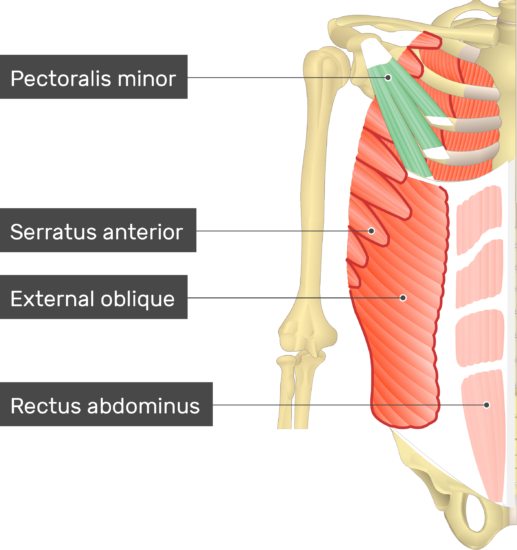KINE 3200 - Chapter 4
5.0(1)
Card Sorting
1/39
Earn XP
Description and Tags
Study Analytics
Name | Mastery | Learn | Test | Matching | Spaced |
|---|
No study sessions yet.
40 Terms
1
New cards
Scapula and Clavicle
- move as a unit
- clavicle’s articulation w/ sternum is only a bony link to the axial skeleton
- clavicle’s articulation w/ sternum is only a bony link to the axial skeleton
2
New cards
Know the bony landmarks
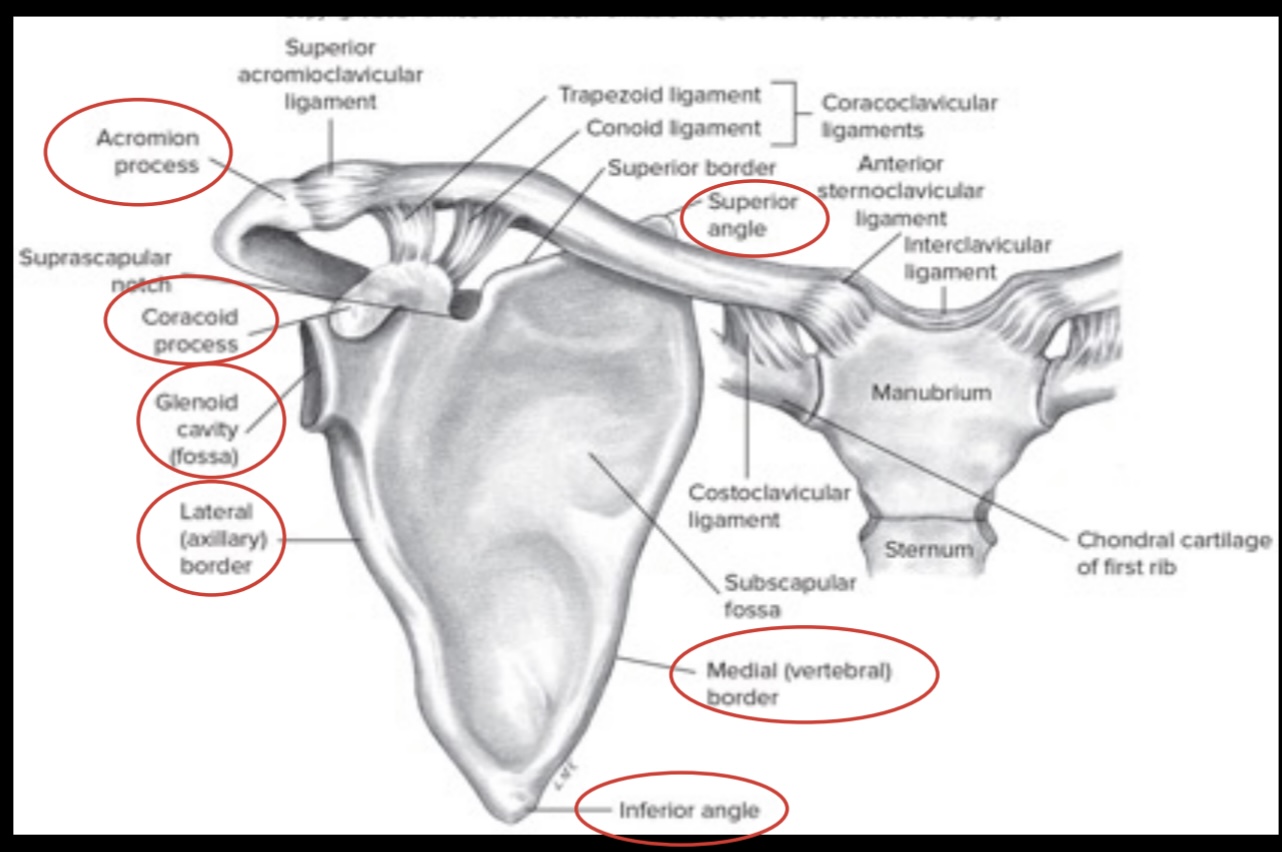
3
New cards
Shoulder Girdle
- upper extremity depends on the shoulder girdle to serve as a base
- ONLY attachment of upper extremity to axial skeleton
- ONLY attachment of upper extremity to axial skeleton
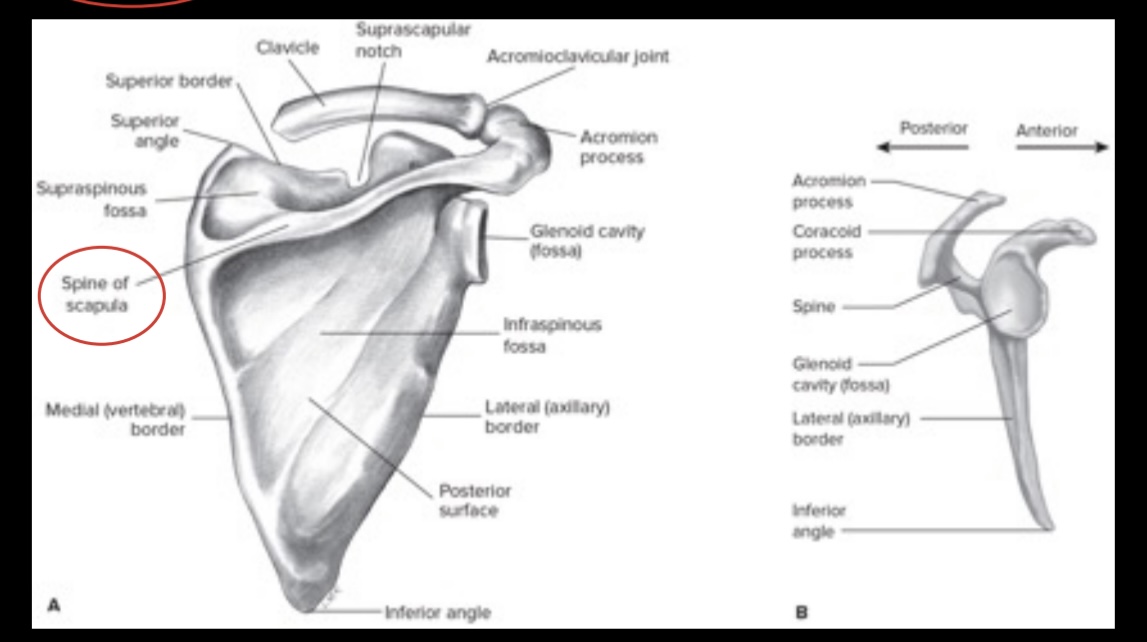
4
New cards
Sternoclavicular (SC) Joint
* link between the clavicle & sternum
- multiaxial, arthrodial joint
- Movements: in relation to manubrium, the clavicle moves
~ protraction/retraction, elevation, depression, slight rotary gliding movements
- multiaxial, arthrodial joint
- Movements: in relation to manubrium, the clavicle moves
~ protraction/retraction, elevation, depression, slight rotary gliding movements
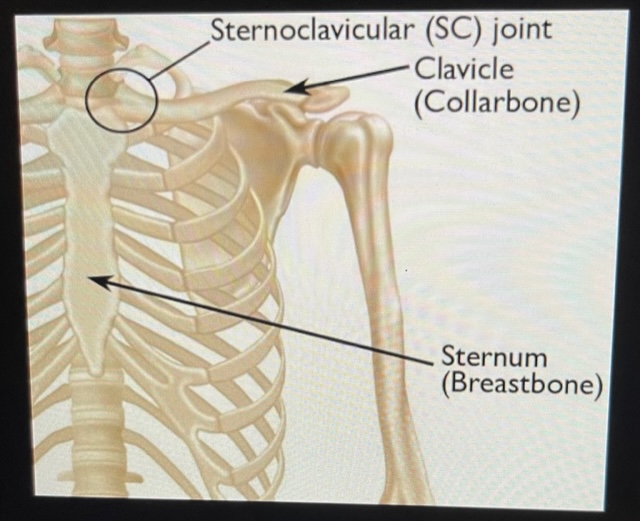
5
New cards
Sternoclavicular (SC) Joint -> Ligamentous support
- anteriorly and posteriorly by the SC ligaments
- Costoclavicular & interclavicular ligaments provide stability
6
New cards
Acromioclavicular (AC) Joint
* joint in the shoulder where 2 bones meet
- Arthrodial classification
- 20º-30º of gliding & rotational motion accompany shoulder girdle & shoulder joint motions
- often injured
- Arthrodial classification
- 20º-30º of gliding & rotational motion accompany shoulder girdle & shoulder joint motions
- often injured
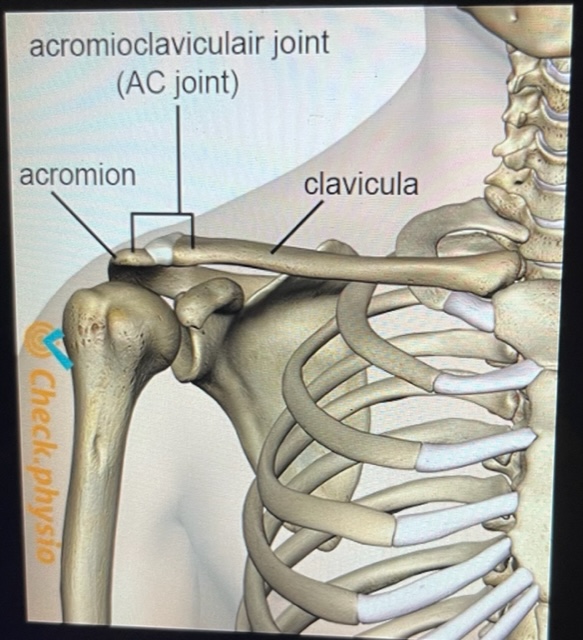
7
New cards
Acromioclavicular (AC) Joint -> Ligamentous support
- Coracoclavicular ligaments
- Acromioclavicular ligaments
- Acromioclavicular ligaments
8
New cards
Scapulothoracic Joint
- Not a true synovial joint, DOESN'T have regular synovial features
- Movement depends on SC & AC joints which allows the scapula to move
~ abduction/adduction
~ upward/downward rotation
~ elevation/depression
- supported dynamically by its muscles
- NO ligamentous support
- Movement depends on SC & AC joints which allows the scapula to move
~ abduction/adduction
~ upward/downward rotation
~ elevation/depression
- supported dynamically by its muscles
- NO ligamentous support
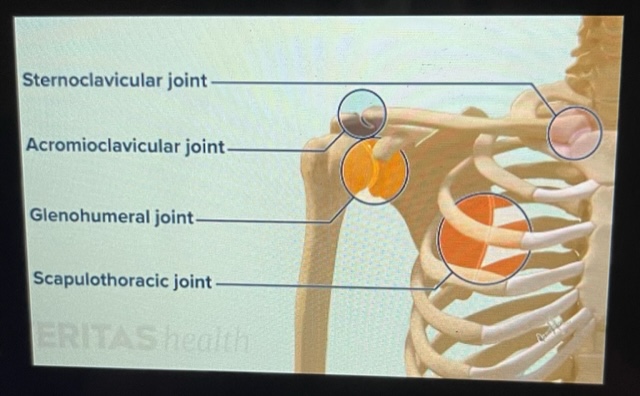
9
New cards
Movements of shoulder girdle
* SC joint provides a majority of the shoulder girdle movements
- Shoulder girdle = scapula movements
- Where scapula goes, clavicle follows
** Shoulder joint & shoulder girdle work together in carrying out upper extremity activities
- Shoulder girdle = scapula movements
- Where scapula goes, clavicle follows
** Shoulder joint & shoulder girdle work together in carrying out upper extremity activities
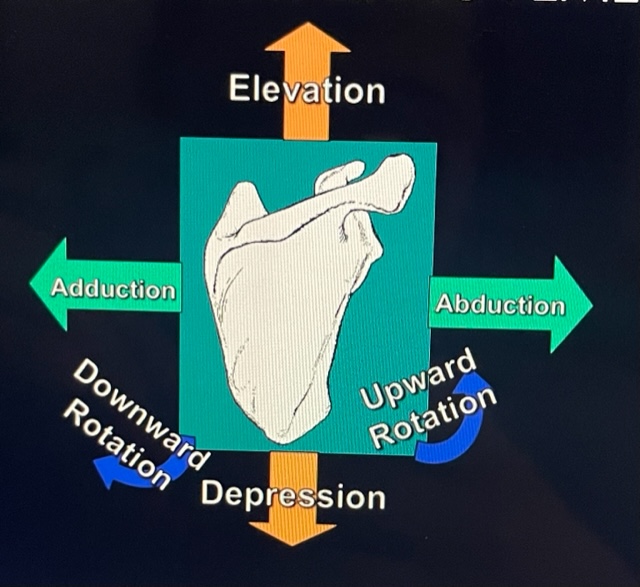
10
New cards
Abduction and Adduction
- Abduction: Scapula moves laterally away from spinal column
- Adduction: Scapula moves medially toward spinal column
- Adduction: Scapula moves medially toward spinal column
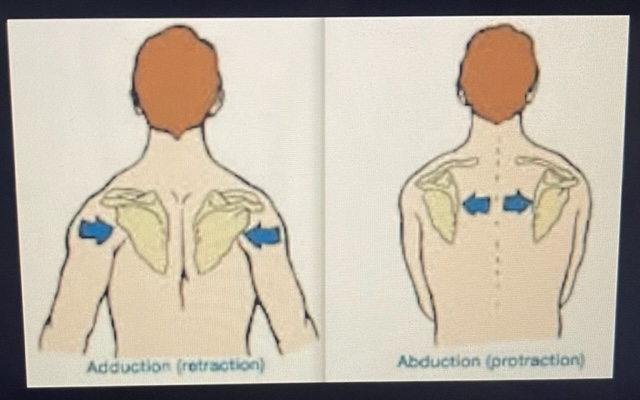
11
New cards
Downward/Upward Rotation
- Downward rotation: Moving the inferior angle of the scapula inferiorly and medially towards the spinal column
- Upward rotation: Moving inferior angle of the scapula superiorly and laterally away from spinal column
- Upward rotation: Moving inferior angle of the scapula superiorly and laterally away from spinal column
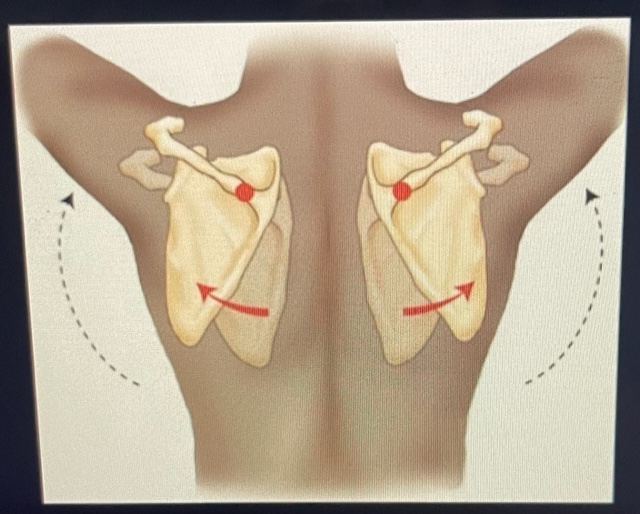
12
New cards
Depression/Elevation
- Depression: Downward or inferior movement of scapula, as in returning to
normal position
- Elevation: Upward or superior movement of scapula, as in shrugging
shoulders
normal position
- Elevation: Upward or superior movement of scapula, as in shrugging
shoulders
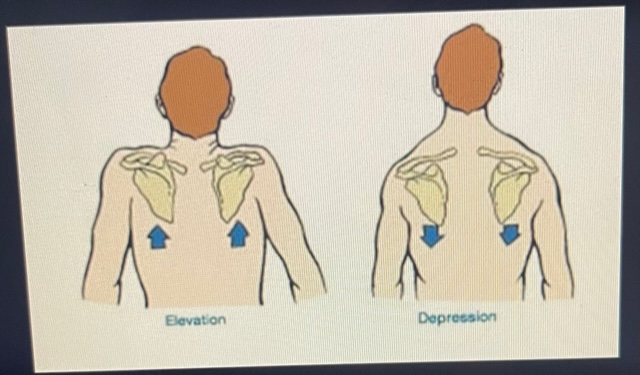
13
New cards
Shoulder Girdle Movements
- for some movements, scapula must rotate on axis
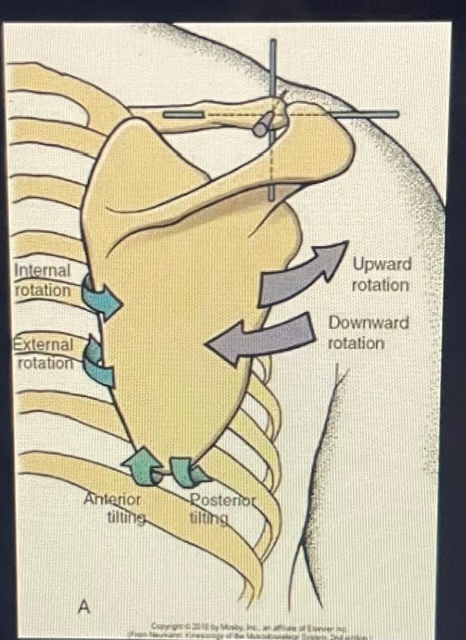
14
New cards
Internal/External Rotation
Internal Rotation (lateral tilt)
- During abduction, scapula rotates about vertical axis resulting in posterior movement of medial border & anterior movement of lateral border
External rotation (medial tilt)
- During extreme adduction, Scapula rotates about its vertical axis resulting in anterior movement of the medial border & posterior movement of lateral border
- During abduction, scapula rotates about vertical axis resulting in posterior movement of medial border & anterior movement of lateral border
External rotation (medial tilt)
- During extreme adduction, Scapula rotates about its vertical axis resulting in anterior movement of the medial border & posterior movement of lateral border
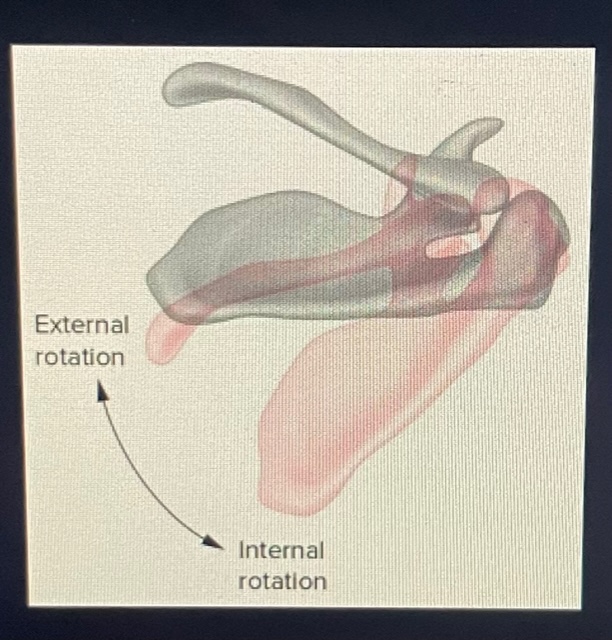
15
New cards
Anterior/Posterior Tilt
Anterior/upward tilt
- Rotational movement of scapula about frontal axis during glenohumeral
hyperextension
- Superior border moves anteroinferiorly & inferior angle moves posterosuperiorly
Posterior/downward tilt
- Rotational movement of scapula about frontal axis during glenohumeral hyperflexion
- Superior border moves posteroinferiorly & inferior angle moves anterosuperiorly
- Rotational movement of scapula about frontal axis during glenohumeral
hyperextension
- Superior border moves anteroinferiorly & inferior angle moves posterosuperiorly
Posterior/downward tilt
- Rotational movement of scapula about frontal axis during glenohumeral hyperflexion
- Superior border moves posteroinferiorly & inferior angle moves anterosuperiorly
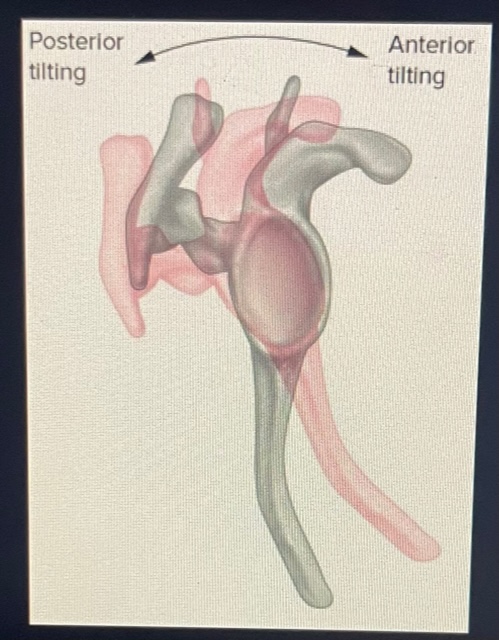
16
New cards
Shoulder girdle muscles
- Stabilize scapula so shoulder joint muscles will have a stable base to move the humerus
- Maintain scapula during shoulder joint actions
- Contract to move shoulder girdle & to enhance movement of upper extremity when shoulder goes through extreme ROM
- 5 muscles primarily involved in shoulder girdle movements
- All originate on axial skeleton & insert on scapula and/or clavicle
- Do not attach to humerus & do not cause shoulder joint actions
- Essential in providing dynamic stability of the scapula
- Maintain scapula during shoulder joint actions
- Contract to move shoulder girdle & to enhance movement of upper extremity when shoulder goes through extreme ROM
- 5 muscles primarily involved in shoulder girdle movements
- All originate on axial skeleton & insert on scapula and/or clavicle
- Do not attach to humerus & do not cause shoulder joint actions
- Essential in providing dynamic stability of the scapula
17
New cards
Shoulder Girdle Muscles
1) Serratus Anterior
2) Pectoralis Minor
3) Trapezius
4) Rhomboid
5) Levator Scapulae
2) Pectoralis Minor
3) Trapezius
4) Rhomboid
5) Levator Scapulae
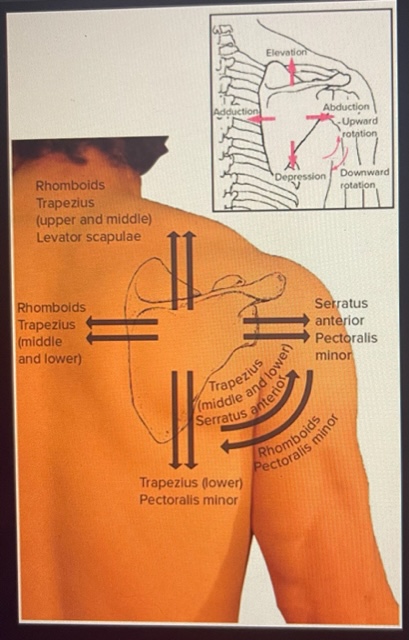
18
New cards
Serratus Anterior
- posterior and lateral
* abduction & upward rotation
* abduction & upward rotation
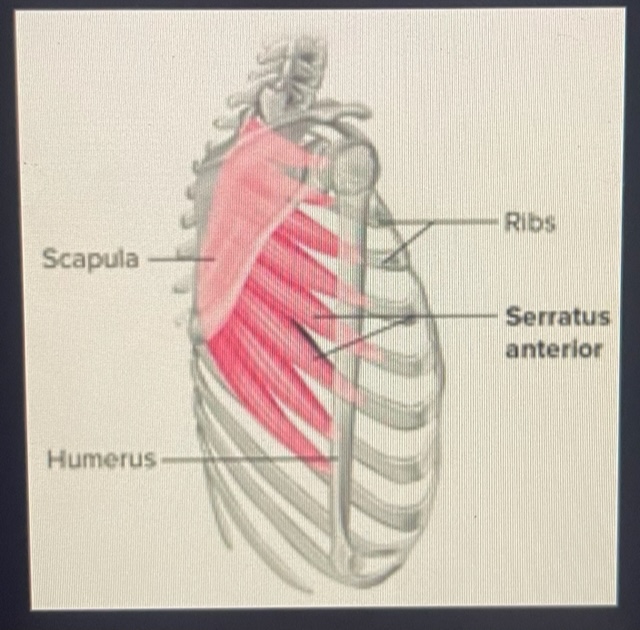
19
New cards
Pectoralis Minor and (subclavius)
- anterior
* abduction, downward rotation, & depression
Subclavis: depression
* abduction, downward rotation, & depression
Subclavis: depression
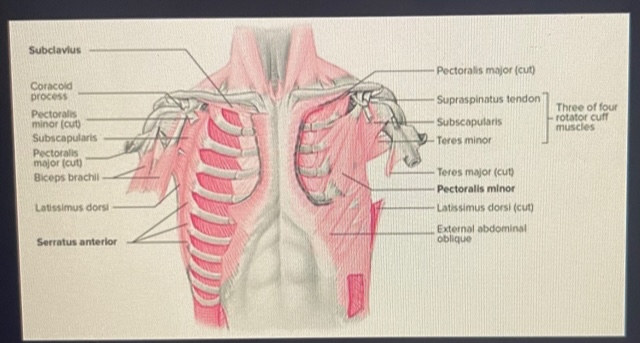
20
New cards
Trapezius
- posterior
- Upper fibers: elevation, head extension
- Middle fibers: elevation, adduction, upper rotation
- Lower fibers: adduction, depression, upper rotation
- Upper fibers: elevation, head extension
- Middle fibers: elevation, adduction, upper rotation
- Lower fibers: adduction, depression, upper rotation
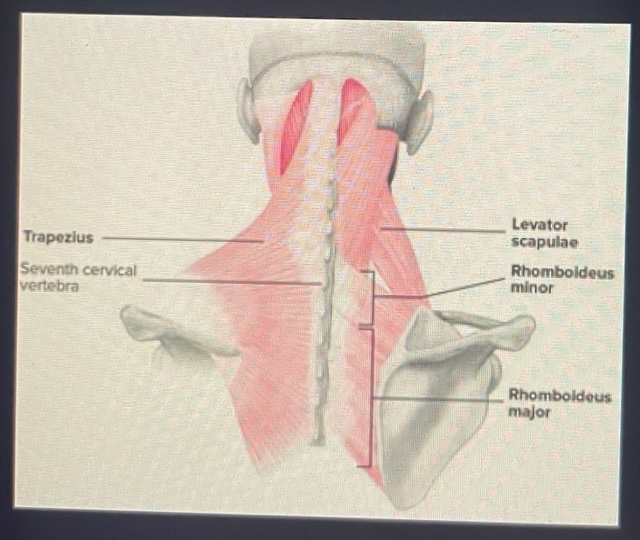
21
New cards
Rhomboid
- posterior
* adduction, downward rotation, elevation
* adduction, downward rotation, elevation
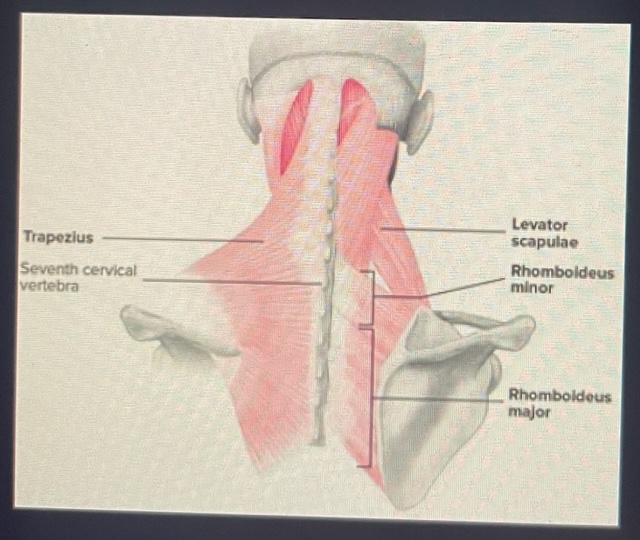
22
New cards
Levator Scapulae
- posterior
* elevation
* elevation
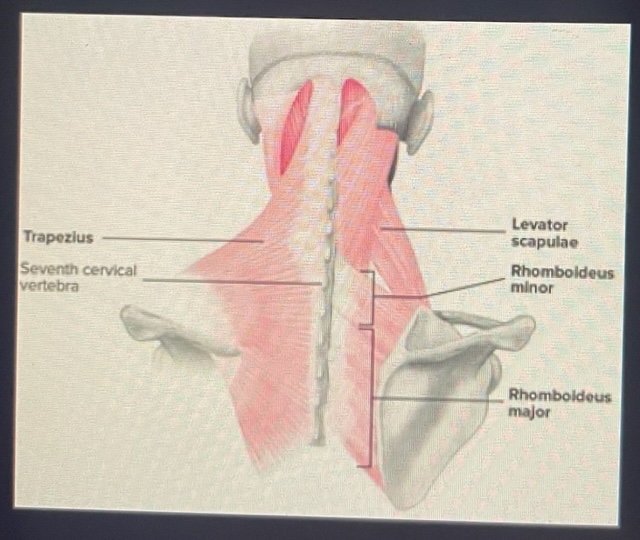
23
New cards
Scapula Muscle Weakness and Posture
- Kyphosis: Forward shoulder due to scapula protractors & depressors becoming stronger & tighter
- Scapula winging: Relatively rare Serratus anterior weakness or paralysis is typically due to injury of the long thoracic nerve
- Scapula winging: Relatively rare Serratus anterior weakness or paralysis is typically due to injury of the long thoracic nerve
24
New cards
Cervical Plexus
- Upper region
- Trapezius, Levator scapula, Rhomboid
- Branches of C3 & C4, C5, spinal accessory nerve
- Trapezius, Levator scapula, Rhomboid
- Branches of C3 & C4, C5, spinal accessory nerve
25
New cards
Brachial Plexus
- Lower region
- Levator scapula, Rhomboid, Serratus anterior, Pectoralis minor
- Branches of C5, C6, C7, C8, T1
- Levator scapula, Rhomboid, Serratus anterior, Pectoralis minor
- Branches of C5, C6, C7, C8, T1
26
New cards
Trapezius (Origin, Insertion, Movements)
- Origin: base of the skull, occipital protuberance, C7, T1-T12
- Insertion: clavicle, acromion process, scapula
- Movements:
~ Upper: scapula elevation, extension & rotation of the head
~ Middle: elevation, upward rotation & retraction of scapula
~ Lower: depression, retraction & upward rotation of scapula
- Insertion: clavicle, acromion process, scapula
- Movements:
~ Upper: scapula elevation, extension & rotation of the head
~ Middle: elevation, upward rotation & retraction of scapula
~ Lower: depression, retraction & upward rotation of scapula
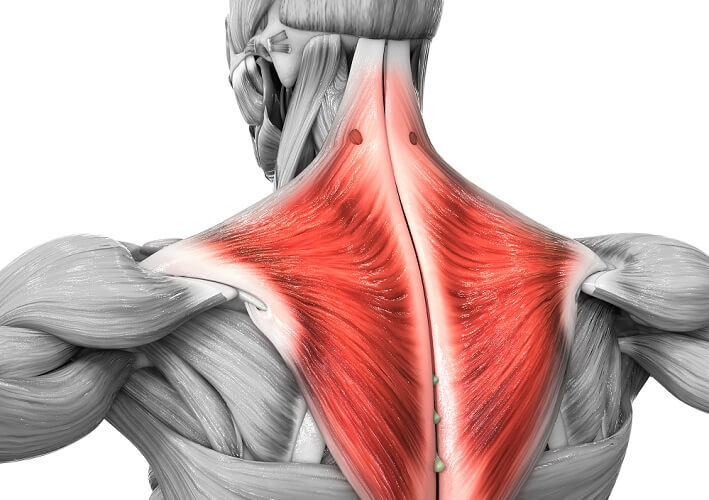
27
New cards
Trapezius
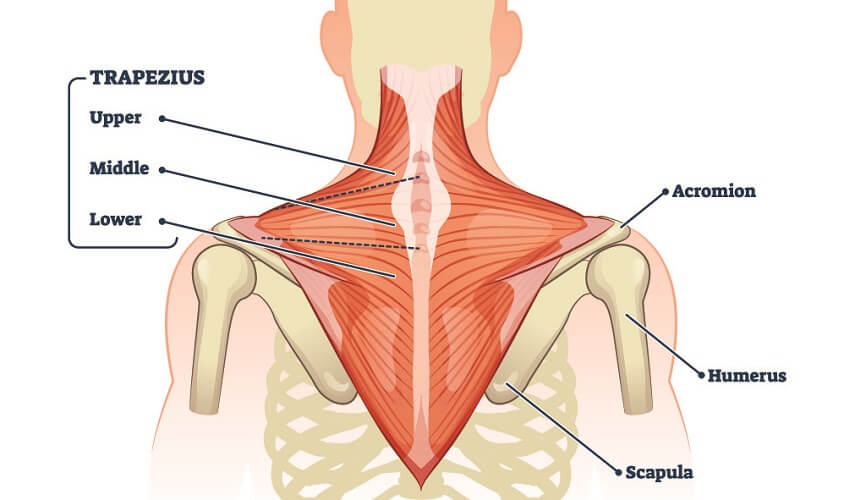
28
New cards
Levator Scapulae (Origin, Insertion, Movements)
- Origin: C1-C4
- Insertion: scapula
- Movements: elevates the medial portion of the scapula, weak downward rotation, and adduction
- Insertion: scapula
- Movements: elevates the medial portion of the scapula, weak downward rotation, and adduction
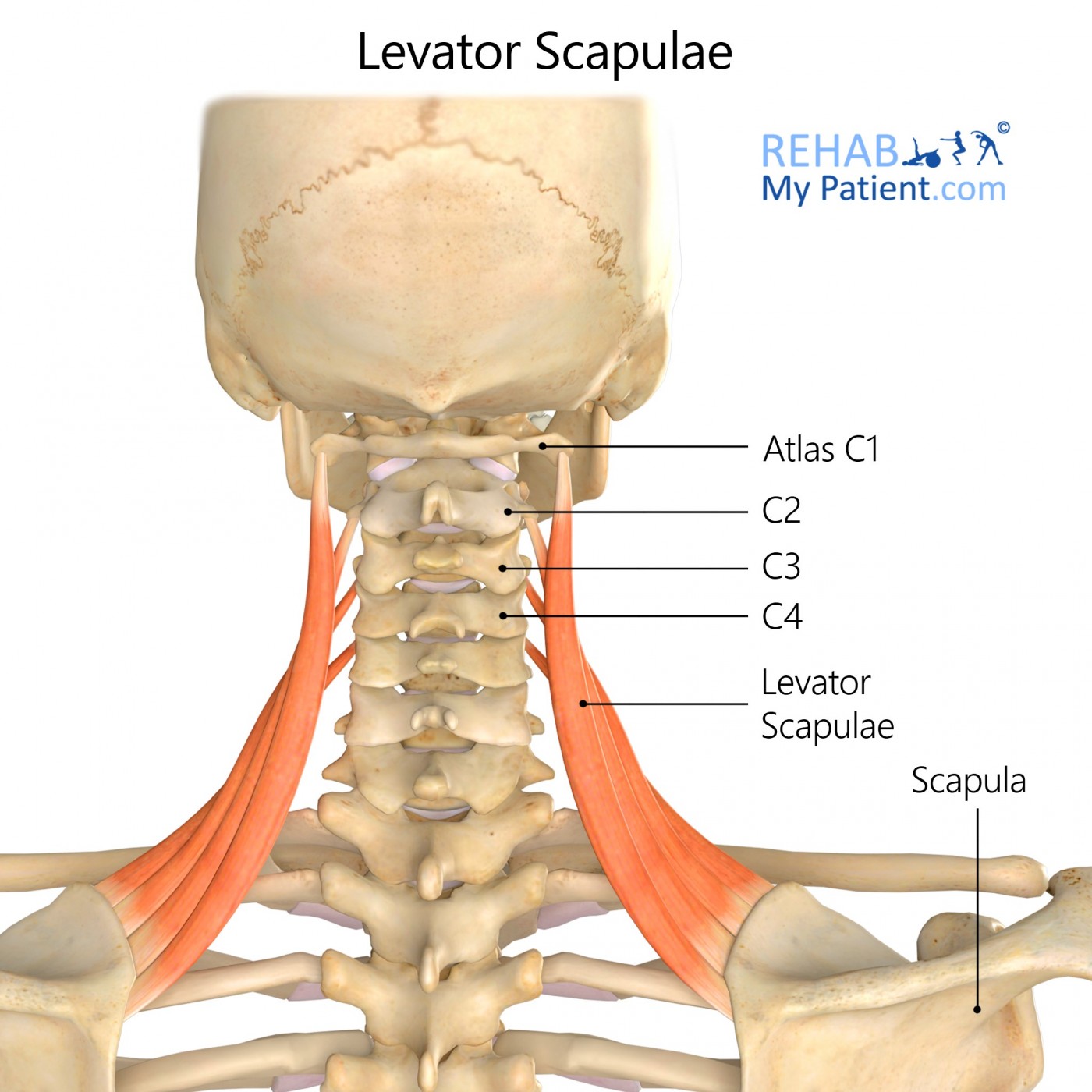
29
New cards
Rhomboid Muscles: Major & Minor (Origin, Insertion, Movements)
- Origin: C7, T1, T2-T5
- Insertion: scapula
- Movements: adduction, downward rotation, elevation
- Insertion: scapula
- Movements: adduction, downward rotation, elevation
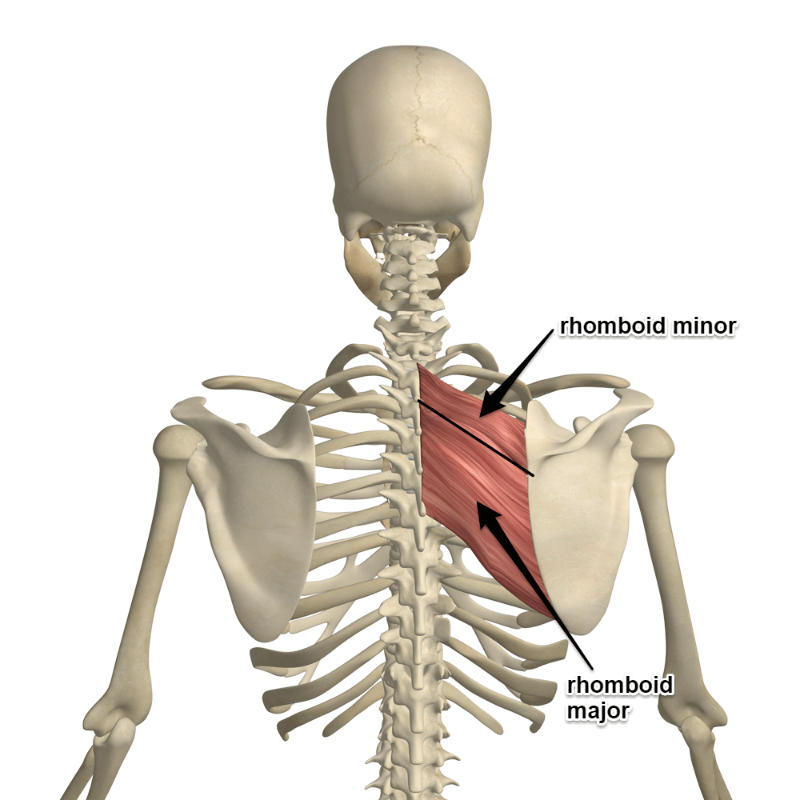
30
New cards
Serratus Anterior (Origin, Insertion, Movements)
-Origin: ribs at the chest
- Insertion: medial scapula
- Movements: abduction and slight upward rotation
- Insertion: medial scapula
- Movements: abduction and slight upward rotation
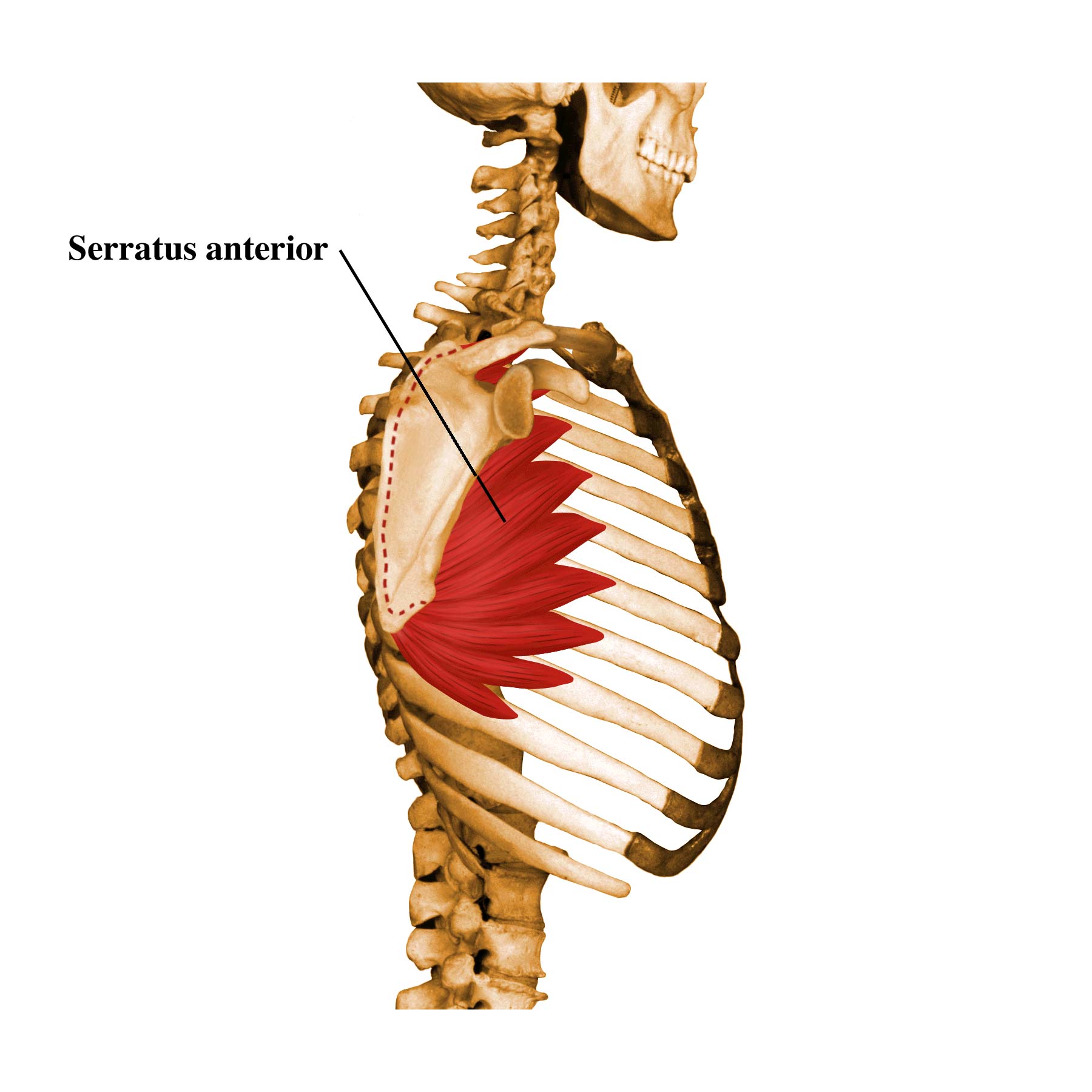
31
New cards
Serratus Anterior
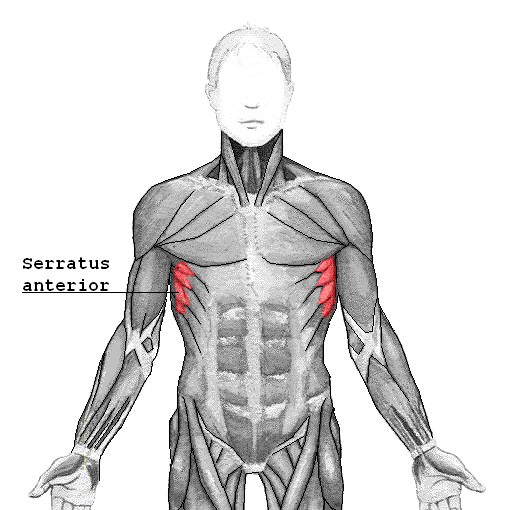
32
New cards
Pectoralis Minor (Origin, Insertion, Movements)
- Origin: ribs
- Insertion: scapula
- Movements: abduction, downward rotation
- Insertion: scapula
- Movements: abduction, downward rotation
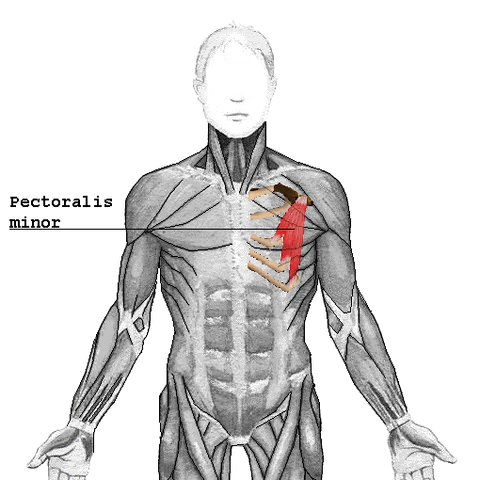
33
New cards
Subclavius (Origin, Insertion, Movements)
- Origin: ribs
- Insertion: clavicle
- Movements: depression and abduction
- Insertion: clavicle
- Movements: depression and abduction
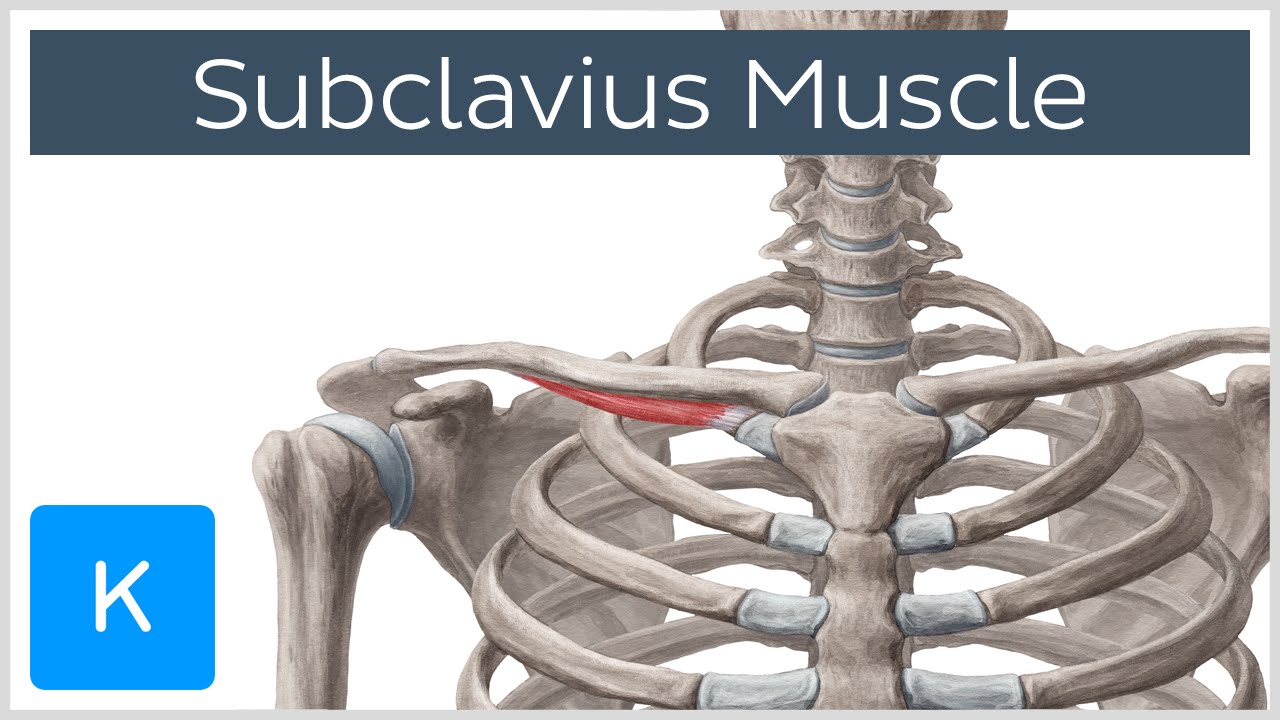
34
New cards
Scapula Abduction (Examples, Agonists)
- Scapula move laterally away from spinous processes without rotation
- Ex: push-ups & bench press
* Agonists: Pectoralis Minor & Serratus Anterior
- Ex: push-ups & bench press
* Agonists: Pectoralis Minor & Serratus Anterior
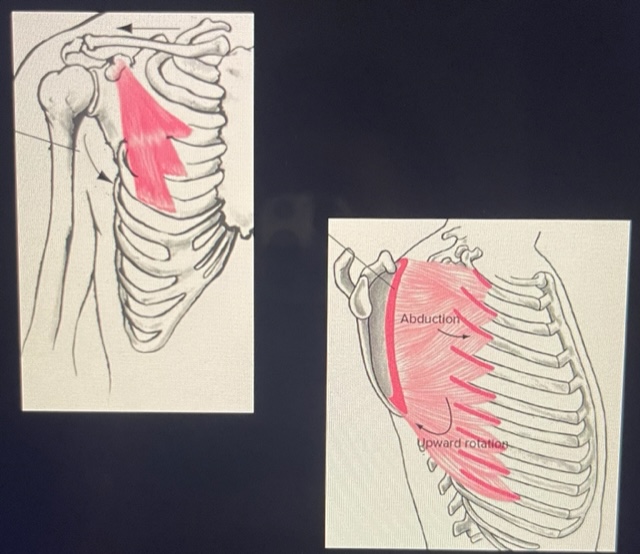
35
New cards
Scapula Adduction (Examples, Agonists)
- occurs with retractions
- Ex: bent-over rows
* Agonists: Middle Trapezius, Lower Trapezius, Rhomboids
- Ex: bent-over rows
* Agonists: Middle Trapezius, Lower Trapezius, Rhomboids
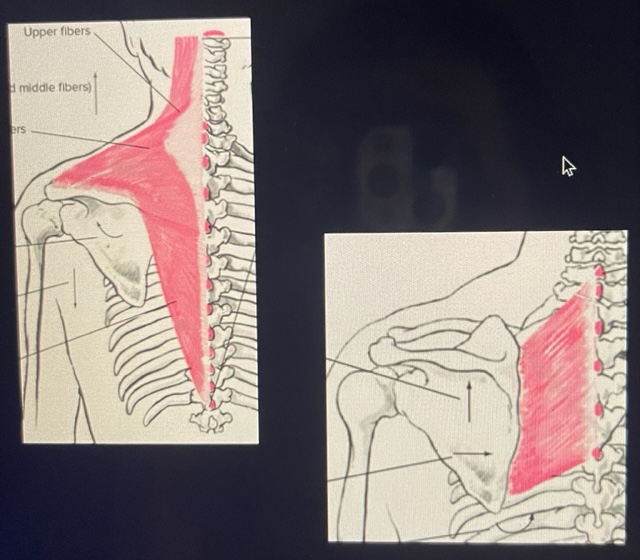
36
New cards
Scapula Upward Rotation (Examples, Agonists)
- lateral & upward movement
- Ex: overhead press
* Agonists: Middle Trapezius, Lower Trapezius, Serratus anterior
- Ex: overhead press
* Agonists: Middle Trapezius, Lower Trapezius, Serratus anterior
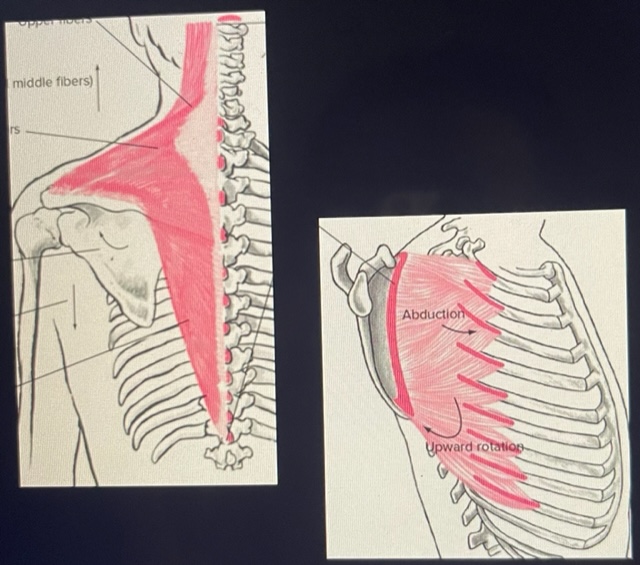
37
New cards
Scapula Downward Rotation (Examples, Agonists)
- downward & medial movements
- Ex: chin-ups and dips
* Agonists: Pectoralis Minor and Rhomboid
- Ex: chin-ups and dips
* Agonists: Pectoralis Minor and Rhomboid
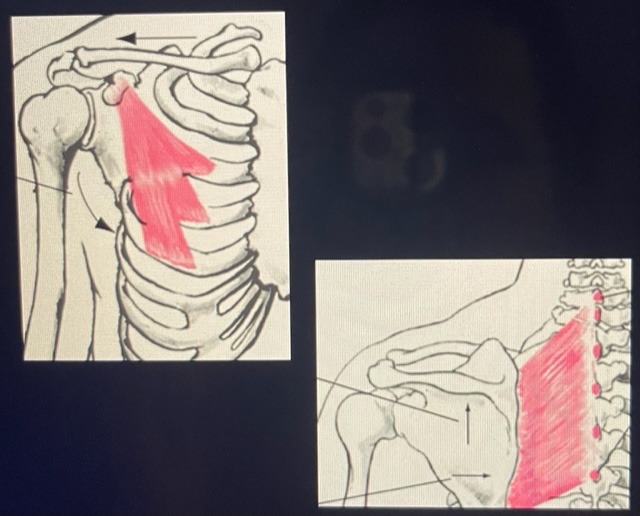
38
New cards
Scapula Elevation (Examples, Agonists)
- lifting scapula without rotation in anatomic position
- Ex: Shoulder shrug
* Agonists: Levator scapula, Upper/middle trapezius, Rhomboid
- Ex: Shoulder shrug
* Agonists: Levator scapula, Upper/middle trapezius, Rhomboid
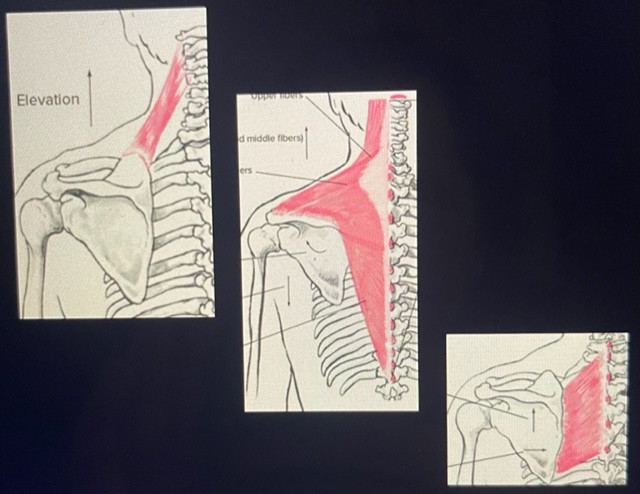
39
New cards
Scapula Depression (Examples, Agonists)
- lowering the scapula
- Ex: Dips
* Agonists: Lower trapezius, Pectoralis minor
- Ex: Dips
* Agonists: Lower trapezius, Pectoralis minor
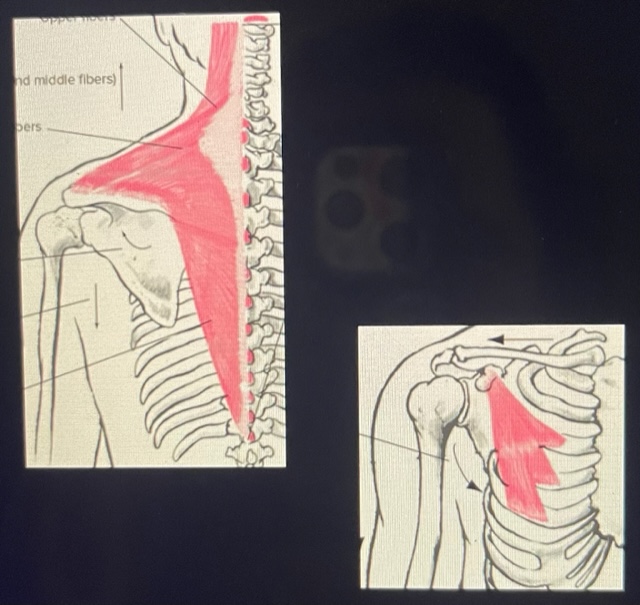
40
New cards
Muscles
